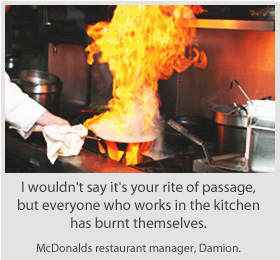Hospital admissions from hot oil burns sustained by workers in commercial kitchens on the rise
Flipping burgers may be a straightforward task, but it is also a dangerous one with new evidence pointing to a sharp increase in hot oil burns in commercial kitchens around Australia.
New data from one of Sydney's biggest hospitals showed hospital admissions for burn injuries up by nearly 50 per cent.
"We are seeing quite a few cases of hot oil burns and we believe that we need to make sure that everyone out there has the appropriate information on both prevention and first aid," said Siobhan Connolly, a burns injury prevention officer at Royal North Shore Hospital.
She said the majority of cases involved burns to the hand, with men making up two-thirds of all reported cases.
Damion, who did not want to provide his last name, is a McDonald's restaurant manager on Sydney's north shore.
He has worked in commercial kitchens for six years and said burns injuries were common.
"You're working on equipment that's kept at temperatures between 170 and 217 degrees, so even the slightest touch is a burn, pretty much," Damion said.
"Everyone who works in the kitchen pretty much starts on the grills, so it's kind of a learning experience.
"I wouldn't say it's your rite of passage, but everyone who works in the kitchen has burnt themselves.
"I remember one guy who was cleaning it. He wasn't doing it properly but he was using a cloth and it popped at him so he got a little burn on his neck."
Damion described the standard treatment procedure in the event that a McDonald's worker sustained a burns injury.
"We give them enough time to go to the washroom, run it under cold water, do the first aid," he said.
"If they're not feeling up to it once they're done, then we take it from there. We usually send them home."
Doubts over quality of first aid provided
But Ms Connolly said the first line of treatment received by many workers was inadequate.
"A lot of the times that we are looking at our burns that come in, the reported adequacy of first aid is less than required," she said.
"So most of the time people will only receive about 10 minutes or so of first aid."
Ms Connolly also chaired the Australia and New Zealand Burns Association Prevention Committee.
She was now looking to take her prevention message nationwide, with a new education program designed to tackle the growing number of burns injuries around the country.
"If you look at the burns out there, there's a lot of them that can be prevented," she said.
A survey carried out on behalf of the US National Council for Occupational Safety and Health found almost 80 per cent of fast food workers in America had suffered burns in the past year.
Another study completed by a US workers' rights group showed about 58 per cent of workers had been burned multiple times because of understaffing and the pressure to work faster.
"We're actually doing quite a bit of work looking at where burns occur, what sort of burns occur, in different areas and we're just about to start that through Australia and New Zealand and target the prevention in that manner," Ms Connolly said.
source:
Categories
- First Aid Kits
-
First Aid Supplies
- Antiseptics
- Bandages
- Bites & Stings
- Burn Creams & Gels
- Dressings
- Eye Care
- Finger Cots
- First Aid Instructions & Reporting
- First Aid instruments
- First Aid Kit Labels
- Infection Control
- Insect Repellent
- Personal Care
- Pharmacy
- Plastic Bags & Modules
- Sports
- Surgical Face Masks
- Tapes
- Thermal Rescue Blanket
- Wound Closure Strips
- First Aid Room
- First Aid Equipment
- First Aid Kit Cases
- Personal Protective Equipment
- Rescue
-
Signs
- Visual Warning
- Braille Signs
- Custom Signs
- Information Signs
-
Safety Signs
- Building & Construction Signs
- Danger Signs
- Door Signs
- Engraved Signs
- Exit Signs
- Fire Safety Signs
- First Aid & Emergency Signs
- Forklift Safety Signs
- Housekeeping Signs
- Kitchen & Food Safety Signs
- Lockout Signs
- Machinery & Operational Signs
- Mandatory Signs
- Mining Signs
- Multilingual Signs
- Multimessage Signs
- No Smoking Signs
- Notice Signs
- Numbers & Letters
- Overhead Signs
- Prohibition Signs
- Property Signs
- Quality Signs
- Recycling Signs
- Safety Information Signs
- Scaffolding Signs
- Sign Posts & Accessories
- UltraTuff Signs
- Warning Signs
- Traffic & Parking Signs
- Warehouse Signs
- Social Distancing & Visitor Control
- Spill Control
-
Workplace Safety
- Asset Management & Security
- Cable & Cord Protectors
- Dangerous Goods
- Drug & Alcohol Testing
- Emblems & Badges
- Fire Safety
- Height Safety
- Labels & Tags
- Labels
- Lockout Tagout
- Manual Handling
- No Smoking
- Safety Posters
- Washroom & Cleaning Products
- Workplace Mats
- PPE Storage & Dispensers
- Skin Care
- Disposable Clothing
- Traffic & Parking
- Hand Sanitising Stands
- GHS
 1300 362 327
1300 362 327 






